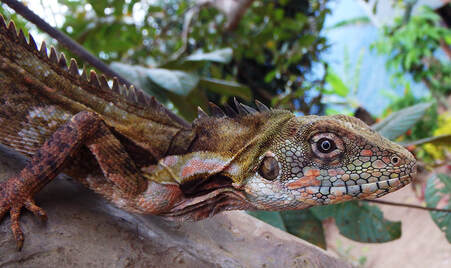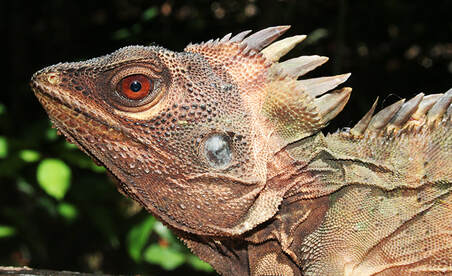 Hypsilurus papuensis (Photo Oliver Tallowin)
Hypsilurus papuensis (Photo Oliver Tallowin)  Lophosaurus dilophus (Photo Oliver Tallowin)
Lophosaurus dilophus (Photo Oliver Tallowin)
Here be dragons; but why? The biogeography and evolution of Melanesian forest dragons (Agamidae)9/2/2020  Hypsilurus papuensis (Photo Oliver Tallowin) Hypsilurus papuensis (Photo Oliver Tallowin) Australia and New Guinea, collectively referred to as the Sahul, share many biotic elements; but could not be more different in terms of climate and geological history. Australia as a landmass is relatively geologically stable, does not have much in the way of mountains and is predominantly covered in arid deserts. In contrast, New Guinea is relatively young in geological terms, has extensive mountains ranges across the entire island and is largely covered in tropical rainforests. From a biogeographical perspective these landmasses present very different opportunities and challenges to their prospective biotic assemblages, and yet, there are some lineages that have diversified throughout both regions. Agamids, also referred to as ‘dragons’, have proliferated in arid Australia represented by over 100 species and have been relatively well studied. With 20 recognised species, Melanesian agamids are much less diverse, have received much less scientific attention, and yet have been shown to be closely related to the Australian clade. In a paper published in the Biological Journal of the Linnean Society, we examine the evolution, biogeography and ecological diversity of Melanesian agamids. We tested whether they originated on the Australian Craton or proto-Papuan islands to the north. Also, we examined to what extent mountains have played a role in Melanesian agamid diversification and tested the evolutionary trends and origins of agamid ecological diversity.  Lophosaurus dilophus (Photo Oliver Tallowin) Lophosaurus dilophus (Photo Oliver Tallowin) In addition to the 11 recognised Melanesian agamids sampled, we found further monophyletic divergent lineages in four taxa. This included two lineages within Hypsilurus modestus, and three within H. magnus, H. papuensis and Lophosaurus dilophus. We found little evidence for micro-endemism in Melanesia with most taxa being widespread and low genetic divergence across the Central Cordillera suggesting these mountains have only recently become a barrier to dispersal. We identified clear evidence of past over-water dispersal in Hypsilurus agamids, with H. modestus lineages dispersing between New Britain, New Ireland and northeast New Guinea. Also, the restricted range of H. schoedei and disjunct distribution of H. longii indicates insular extinction events may have occurred. We identify the Australian Craton as the ancestral area of Lophosaurus and all Australo-Papuan agamids. However, Hypsilurus were clearly able to disperse over water and show deep divergences in the Melanesia region. The distribution of extant Hypsilurus lineages suggests a history of allopatric speciation on former islands with some now accreted onto New Guinea. We infer from the biome evolution analysis that Australo-Papuan agamids were associated with rainforests which date back to the early Miocene, but also that agamids had similarly long histories in other biomes. This indicates that while the rainforest biome might well be ancestral for many Australian radiations, semi-arid or seasonal environments also have a long history in Sahul. Finally, we note the disparity in ecological diversity within Australo-Papuan agamids. Despite their long history in rainforest regions there is a complete lack of Melanesian terrestrial or semi-terrestrial agamids compared with the Australian assemblage. This reflects fundamental differences in how these lizards diversify in dry versus wet habitats and suggests adverse environmental conditions, such as reduced solar radiation, as well as biotic interactions, such as competition or predation, form a barrier to ecological diversification in rainforest biomes. Author: Oliver Tallowin
0 Comments
Leave a Reply. |
AuthorMainly maintained by Shai Meiri and Uri Roll Archives
October 2022
Categories
All
|
